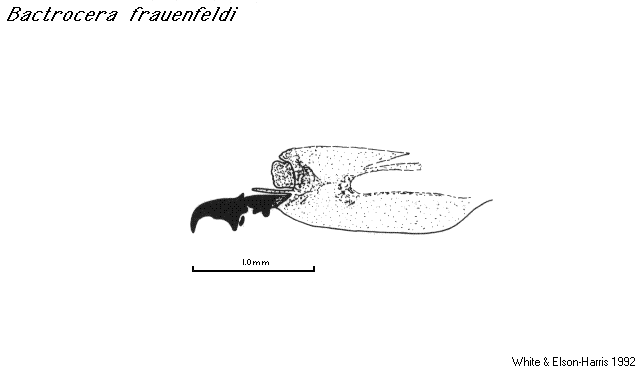Bactrocera frauenfeldi
Description
Typical of Bactrocera larvae with the following specific characteristics for the third instar:
Body. Body length 5–7.5mm.
Head. Stomal organ: peg sensilla short, stout; other peg-sensilla-like structures absent. Stomal region: secondary lobes short, leaf-like (5 preoral lobes); margins of secondary lobes all entire. Number of oral ridges 9–12; margins scalloped (moderately long, deeply serrated rows of long, parallel-sided, bluntly rounded teeth; fringelike). Accessory plates a mixture of long and short interlocking plates; number of accessory plates 13 (~~); margins unserrated or serrated (several with small serrations). Median oral lobe absent or not protruding.
Spinules and creeping welts. Dorsal spinules on segments T1-T3.
Anterior spiracles. Anterior spiracle convex to flat (?). Anterior spiracular tubules 9–12.
Caudal segment (a8) and anal lobes. Anal lobes plainly visible, but not protuberant; simple.
Posterior spiracles. Slits 3.5–4x longer than wide (about). Dorsal spiracular processes with numerous trunks arising from an elongate base (long processes). Number of dorsal spiracular processes 12–16. Number of ventral spiracular processes 12–16. Number of lateral spiracular processes 6–9.
Host plants
Highly polyphagous, infesting at least the following families and genera:*
| Family | Genus |
| Anacardiaceae | Anacardium, Dracontomelon, Mangifera, Spondias |
| Annonaceae | Annona, Cananga |
| Apocynaceae | Cerbera, Ochrosia |
| Araucariaceae | Agathis |
| Calophyllaceae | Calophyllum, Mammea |
| Caricaceae | Carica |
| Celastraceae | Celastrus |
| Clusiaceae | Garcinia |
| Combretaceae | Terminalia |
| Cucurbitaceae | Trichosanthes |
| Ebenaceae | Diospyros |
| Euphorbiaceae | Aleurites |
| Fabaceae | Inocarpus |
| Goodeniaceae | Scaevola |
| Hernandiaceae | Hernandia |
| Lauraceae | Persea |
| Lecythidaceae | Barringtonia |
| Malpighiaceae | Malpighia |
| Malvaceae | Heritiera |
| Melastomataceae | Melastoma |
| Meliaceae | Sandoricum |
| Moraceae | Artocarpus, Broussonetia, Ficus |
| Musaceae | Musa |
| Myrtaceae | Eugenia, Psidium, Syzygium |
| Oxalidaceae | Averrhoa |
| Passifloraceae | Passiflora |
| Phyllanthaceae | Baccaurea |
| Rhamnaceae | Ziziphus |
| Rubiaceae | Guettarda, Nauclea |
| Rutaceae | Citrofortunella, Citrus, Clymenia, Fortunella |
| Sapindaceae | Pometia |
| Sapotaceae | Burckella, Chrysophyllum, Manilkara, Niemeyera, Pouteria |
| Thymelaeaceae | Phaleria |
*See Liquido et al. (2017)
Part of plant attacked: fruit.
Biogeographic region and distribution
AustralasianBelau and Northern Marianas to New Guinea and Gilbert Islands; introduced Australia (Qld.).
Adult taxonomy
Bactrocera (Bactrocera) frauenfeldi (Schiner)Dacus frauenfeldi Schiner 1868: 262.—Solomon Is. Stuart I. LT ♀ NMW. Lectotype designated by Hardy 1968: 138.
References
Carroll, L. E., A. L. Norrbom, M. J. Dallwitz, and F. C. Thompson. 2004 onwards. Pest fruit flies of the world – larvae. Version: 8th December 2006. http://delta-intkey.com.
Liquido, N. J., G. T. McQuate, K. L. K. Lee, K. A. Nakamichi, A. L. Birnbaum, A. P. K. Tateno, and M. A. Hanlin. 2017. Host plant records of the mango fruit fly, Bactrocera (Bactrocera) frauenfeldi (Diptera: Tephritidae), Version 1.0. Available online at: USDA Compendium of Fruit Fly Host Information (CoFFHI), Edition 3.0, https://coffhi.cphst.org/.



